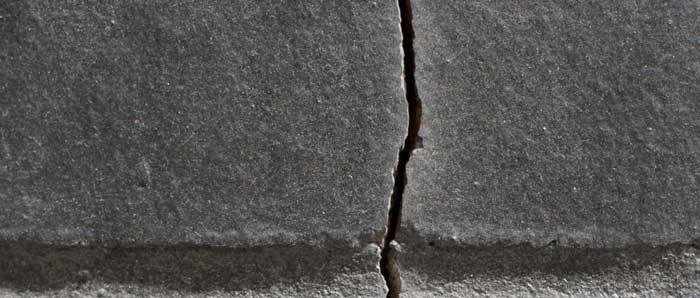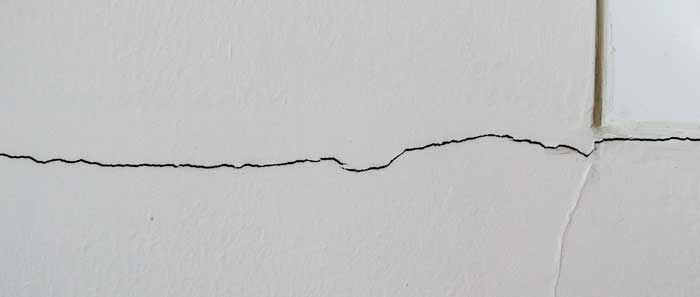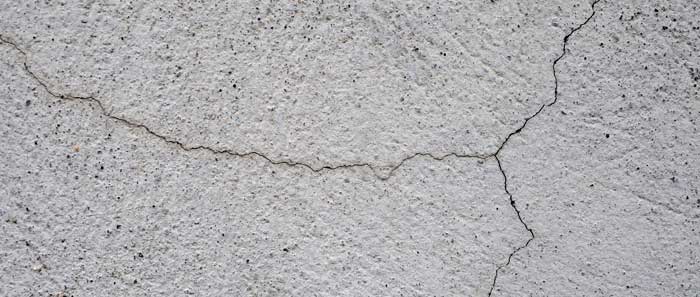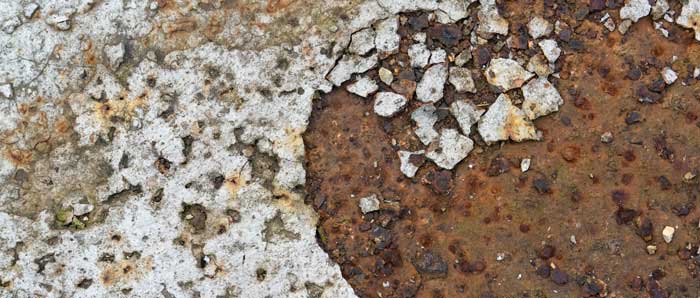Whether you’ve owned your home for 20 years or just one, nothing can induce more panic than something going wrong, especially if it’s expensive. And learning you might have foundation issues is the pinnacle of homeowner problems.
The first sign you might have an issue is a crack in your foundation wall. Depending on the size and scope of the crack, you could be dealing with something as tiny as a cosmetic issue or as large as your foundation failing. And when that happens, your house may not be able to support you and your family safely.
To help you gain a better understanding of the severity of your issues, this guide will answer the following questions:
A simple crack could mean several things, but if there’s even a possibility that it could be a foundation problem, then it’s important to know what to look for as you do maintenance checks. Read on to learn what a technician will look for when he examines your foundation and to understand what you’re getting into after you notice a crack.
Before you notice a crack in your foundation, there are a couple of other places where you might see signs that your house’s structure may be failing. These examples can be a sign for homeowners without a basement or easily accessible crawlspace.
Below, we’ve covered a few ways to check for basement or structural issues even when your house’s layout or design makes it difficult.
When you have an unfinished basement, cracks and other underlying problems are apparent because you’re getting a direct glimpse at your building’s structure. In a finished basement, however, you have to look at the minor details to really assess the situation.
If you can, check the stud behind a finished wall to see if there’s any evidence of moisture or past seepage. After it rains, go downstairs and look for any signs of leaks due to cracks or bad sealant.
If it’s too difficult to access anything behind your drywall or paneling, there are some places to look outside of your basement or crawlspace.
Not every house has a basement or crawlspace, so looking for structural problems can seem daunting.
Here are a couple of other indicators that could mean your foundation is failing:
Cracks can happen for many reasons — it all depends on the type of foundation you have, the way your house was constructed, grading, terrain, and drainage around your structure.
We’ve been working with foundations for over 30 years, and we’re here to help.
Due to construction material, presence of water, and soils in our area, settlement is not an uncommon occurrence. When cracks are left untreated, problems can expound into bigger issues, both structurally and cosmetically.
Here’s a short list of just some things that might cause your foundation to crack:
Not every crack is a sign that your foundation is failing, however. In fact, some are just minor seepage cracks that can be treated with an injection. In other words, these cracks don’t get longer or wider, and they are formed naturally as concrete ages and just need to be filled.
Cracks do become a problem when they’re actively changing or shifting — especially if they’re becoming wider as time goes on. If you see a crack that is wider than a quarter of an inch, you need to call an expert to make sure your foundation isn’t failing. Use the ruler below to keep track of the width of any crack you see in your foundation.

We’ve been working with foundations for over 30 years, and we’re here to help.
Now that you have a pretty good idea of what a foundation crack is and what it isn’t, you should know what types of cracks you’re looking for. As you’ve already learned, some might be benign, while others are active and could lead to extensive repairs. But there are also different shapes, and each one means something different to a technician.
Learning how to identify each one will become vital as you do maintenance and upkeep checks around your house. Here are six different types of cracks and what they mean:

Vertical cracks run top to bottom and can have any length or width. These cracks may be seepage cracks or early signs of vertical settlement.
You should still keep an eye on these cracks, however. Vertical cracks can lead to problems with bugs or leaks in your basement or crawl space area. If these aren’t sealed properly, the leakage can get worse as time goes on.

When it comes to vertical vs. horizontal cracks, horizontal ones are typically deemed more pressing. Horizontal cracks run from left to right in your foundation wall. Most horizontal cracks are indicative of one of two things:
Lateral failure means that your foundation wall is moving inward due to excessive water pressure. If your house does not have a way to drain water away from your foundation, such failure is likely to happen. When a wall is bowing in the middle, it is likely laterally failing.
When a construction company goes to pour a foundation, it will use a recessed reinforcing bar (rebar) within the walls of the foundation. Rebar pop happens when the rebar is too close to the outer edge of the wall, forcing it to fold or break.

Diagonal cracks in the foundation typically start atop and run at a diagonal toward corners. We already discussed how a wall that is laterally failing bows in the middle, but it can also rotate, which is why you’re seeing that diagonal crack. When the wall is rotating, the bottom is staying where it’s at, but the top of the wall is rolling inward.

Map cracking is a small web of breaks in the concrete. These are usually just cosmetic, but they should be monitored. If they start spreading out or getting wider, call a technician.

Hairline cracks are narrow but continue through the foundation. They’re typically vertical, and they might be wider at the top but get smaller as they travel down the wall. Because they continue to the outside soil, you might have some water seepage in your basement. As we’ve already discussed, oversaturation can create more significant structural issues, so seal and waterproof these cracks if you do find water.

Spalling cracks are wide surface cracks that follow the direction of rebars. They often look like the concrete is flaking off, and they’re typically the result of excess water corroding your rebars. This usually happens in older homes, especially in ones where the foundation was made with brick or natural stone.
Every type of crack is different, so it’s not only essential to know what caused the crack, but also how to fix it.
We’ve been working with foundations for over 30 years, and we’re here to help.
Depending on the exact nature of the crack, there are a number of things that can be done to either stop the crack in its tracks or fix your foundation altogether.
Here are some of the most common methods based on what your foundation needs help with:
When the crack is minor, you can use epoxy resin injections within the crack to fill and reseal the crack from the inside.
Many technicians use epoxy for these minor repairs because it starts as a liquid and can form to the crack. As it hardens, it becomes waterproof, preventing the crack from getting any bigger. Many times, you’ll see this resolution used to stop water.
Similar to the epoxy method, carbon fiber strips are used to bond the distance between the crack to increase the structural strength of your foundation’s concrete. These strips are most often used if your wall is bowing or if the cracks to be repaired are wider than a hairline.
When it comes to settlement damage, technicians can typically resolve them using many types of piers.
Piers are essentially vertical steel piles that are driven to a known holding capacity. These are usually used when your foundation is settling to help your foundation bear the weight of your house.
Chance helical wall anchors and carbon fiber wall reinforcers, on the other hand, are used to reinforce your walls laterally to create better foundational stability. Carbon fiber wall reinforcers are easy to install without excavating or drilling, but act 10 times stronger than steel. While helical wall anchors do require drilling, however, this option is a permanent solution, eliminating bowing or rotating walls.
Depending on the scope of the repair, you could find yourself out of a lot more money than you were anticipating. Epoxy resin solutions can be done for a low cost, but as you dive into whether you need helical wall anchors, carbon fiber solutions, or even a brand-new foundation, the price goes up quite a bit. You could wind up spending anywhere from $2,000 to $10,000 and up.
That can be somewhat daunting for anyone, which is why it’s important to look for cracks each season and to monitor them as they appear. However, if you do discover you have a serious foundation problem, make sure you look for a company that offers financing.
When it comes to your foundation, there is no one-size-fits-all approach to repairs. A technician will help guide you if you find that your home is undergoing serious foundational issues.
We’ve been working with foundations for over 30 years, and we’re here to help.
While every aspect of your home’s maintenance is important, ensuring your house is stable from the get-go will help you avoid the costly damage we mentioned above. The most important thing to consider when you’re preventing foundation damage from occurring is oversaturation.
You need to do everything you can to control the water on your house’s lot so that your foundation isn’t shrinking and expanding often — and that means waterproofing. We’ve created a checklist to help you keep track of everything you need to do to keep your foundation steady each year.
Use this checklist to make sure that you are doing everything you can to prevent foundation cracks and other issues from arising.
We’ve been working with foundations for over 30 years, and we’re here to help.
Cracks in your foundation and other structural problems are enough to give any homeowner anxiety. It takes a lot of knowledge and skill to see a crack, find the root of the problem, and fix it the right way the first time.
Let us do a free estimate on your foundation repairs. We’ll come in, take a look at cracks and other problems throughout your home, and give you our expert opinion. What’s more, if we do discover there’s a major repair, we’ll work with you on financing options.
We’ve been working with foundations for over 30 years, and we’re here to help.